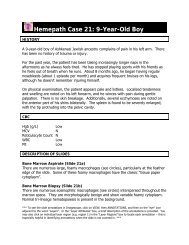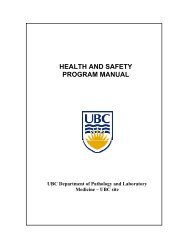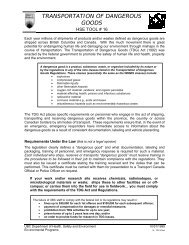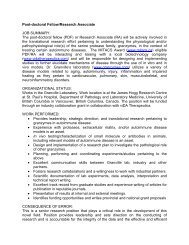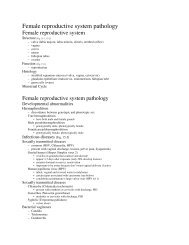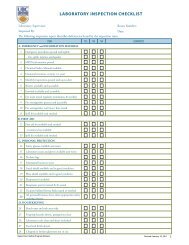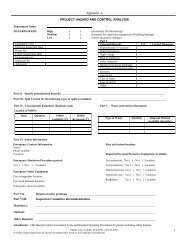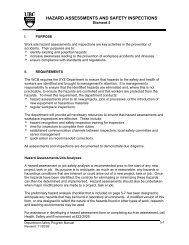ABSTRACT #28CLINICAL SCIENCESGRADUATE STUDENTPOSTER presentationPhenotypic characterization <strong>and</strong> cardiovascular outcomes <strong>of</strong> patients withfamilial hypercholesterolemiaMatt Allard 1 , Michal Martinka, Ahmad Al-Sarraf, Dan Holmes, Jiri Frohlich1Healthy Heart Prevention Clinic, St. Paul's Hospital/ Providence Health CareBackground /objectivesFamilial hypercholesterolemia (FH) is a common autosomal dominant disorder caused by loss-<strong>of</strong>-functionmutations in the low-density lipoprotein (LDL) receptor (LDL-R) or apolipoprotein B-100 (apo B) gene, orgain-<strong>of</strong>-function mutations in proprotein convertase subtilisin/kexin type 9 (PCSK9), resulting in very highblood cholesterol levels <strong>and</strong> premature cardiovascular disease (CVD).To identify <strong>and</strong> phenotypically characterize patients in the Healthy Heart Prevention Clinic with FH todetermine characteristics that increase their risk <strong>of</strong> developing CVD.40MethodsPerform a chart review <strong>of</strong> the FH patients in the Prevention Clinic <strong>and</strong> use <strong>of</strong> the Cardiac Registry to determinewhich patients in this cohort developed CVD (Group 1).ResultsPreliminary work on 354 patients revealed that 72 had evidence <strong>of</strong> CVD. The average age <strong>of</strong> these patients(Group 1) is 69.7 with 58.3% being male. The 282 FH patients not found to have evidence <strong>of</strong> CVD (Group2) have an average age <strong>of</strong> 60.9 with 41.5% being male. Based upon the Dutch Lipid Clinic Network Criteria,90.3% <strong>of</strong> Group 1 was defined as having definite FH compared to 54.6% <strong>of</strong> Group 2. There were some notabledifferences in CV risk factors between the 2 groups. In the patients <strong>of</strong> Group 1 62.5% had a family history <strong>of</strong>premature CVD, 37.5% had history <strong>of</strong> hypertension, <strong>and</strong> 59.7% developed tendon xanthomas. In Group 251.1% had a family history <strong>of</strong> premature CVD, 18.8% had a history <strong>of</strong> hypertension, <strong>and</strong> 35.1% developedtendon xanthomas. Lastly, there is a large difference in the Lp(a) values <strong>of</strong> the two groups with Group 1 having anaverage Lp(a) value <strong>of</strong> 799.4 mg/L <strong>and</strong> Group 2 having an average Lp(a) value <strong>of</strong> 541.1 mg/L.ConclusionsDiagnosis <strong>of</strong> definite FH, older age, presence <strong>of</strong> tendon xanthomas, family history <strong>and</strong> high Lp(a) levels weremuch more prevalent in patients who developed CVD. Identifying these risk factors will allow for earlier <strong>and</strong> moreaggressive management to reduce the risk <strong>of</strong> CVD.2012 * Oral/Poster Presentations
POSTER presentationGRADUATE STUDENTBASIC SCIENCESABSTRACT #29Characterization <strong>of</strong> Stress Granules in the Coxsackievirus Type B3 InfectionGabriel Fung 1 , Chen Seng Ng 2 , Jingchun Zhang 1 , Honglin Luo 11<strong>University</strong> <strong>of</strong> British Columbia, James Hogg Research Centre, Department <strong>of</strong> <strong>Pathology</strong> <strong>and</strong><strong>Laboratory</strong> <strong>Medicine</strong>; 2 Kyoto <strong>University</strong>, Department <strong>of</strong> Molecular GeneticsBackground /objectivesCoxsackievirus type B3 (CVB3) is a non-enveloped, positive single-str<strong>and</strong>ed enterovirus that infects the heart,pleura, pancreas <strong>and</strong> liver. CVB3 infection can cause myocarditis, <strong>and</strong> its sequelae, dilated cardiomyopathy(DCM). In North America, DCM accounts for approximately 20% <strong>of</strong> heart failure <strong>and</strong> sudden death inchildren <strong>and</strong> young adults. Stress granules (SGs) are dynamic cytosolic aggregates composed <strong>of</strong> messengerribonuclearproteins (mRNPs) <strong>and</strong> target mRNAs <strong>and</strong> play an important role in mRNA storage <strong>and</strong> metabolismduring stress. SG formation has been implicated in several human diseases including viral infection,inflammation, cancer <strong>and</strong> multiple neurological diseases. We aim to elucidate the mechanism <strong>and</strong> significance<strong>of</strong> SGs in CVB3 infection. Underst<strong>and</strong>ing the underlying molecular mechanisms <strong>of</strong> CVB3 replication <strong>and</strong> SGformation may aid in developing therapeutic treatments for CVB3-induced diseases.Hypothesis: CVB3-induced Stress Granule formation plays a protective role in the CVB3 infectionMethodsHeLa cells stably expressing GFP-tagged Ras-GAP SH3 domain binding protein (G3BP1), a protein involvedin the assembly <strong>of</strong> SGs, were used to monitor the formation <strong>of</strong> SGs during CVB3 infection. To explorethe potential mechanism by which CVB3 regulates SG formation, we examined protein expression <strong>of</strong>eIF4γ(gamma), phospho-eIF2α(alpha), G3BP1, <strong>and</strong> T-cell restricted internal antigen (TIA-1), another criticalprotein that participates in SG assembly, in CVB3-infected cells. Finally, RT-PCR, immunoblot <strong>and</strong> plaqueassays were used to investigate the significance <strong>of</strong> G3BP1 by overexpressing <strong>and</strong> siRNA knockdown in HeLacells.ResultsConfocal imaging showed punctate accumulation <strong>of</strong> GFP-G3BP1 fluorescence in the cytosol at ~3 hours postinfection (hpi) <strong>and</strong> disappearance ~5 hpi, while GFP-G3BP1-Q325E mutants (cleavage resistant mutant)retained SG formation throughout CVB3 infection. By immunoblot, we showed that eIF4γ(gamma) wascleaved early after viral infection <strong>and</strong> eIF2α(alpha) became phosphorylated at ~5 hpi. Protein level <strong>of</strong> TIA-1remained unchanged while G3BP1 cleavage was observed ~5 hpi. Finally by RT-PCR, immunoblot <strong>and</strong> plaqueassay, viral replication was significantly reduced in G3BP1 overexpressing cells compared with wild-type HeLacells. Furthermore, knockdown <strong>of</strong> G3BP1 resulted in increased viral production.ConclusionsOur results suggest that translation initiation inhibition is likely the cause <strong>of</strong> SG formation during the earlyphase <strong>of</strong> CVB3 infection, however at the late stage <strong>of</strong> viral infection, disassembly occurs due to G3BP1 cleavageat amino acid Q325. Our data also suggest a protective role <strong>of</strong> G3BP1 in SGs during CVB3 infection.Oral/Poster Presentations * 2012 41




